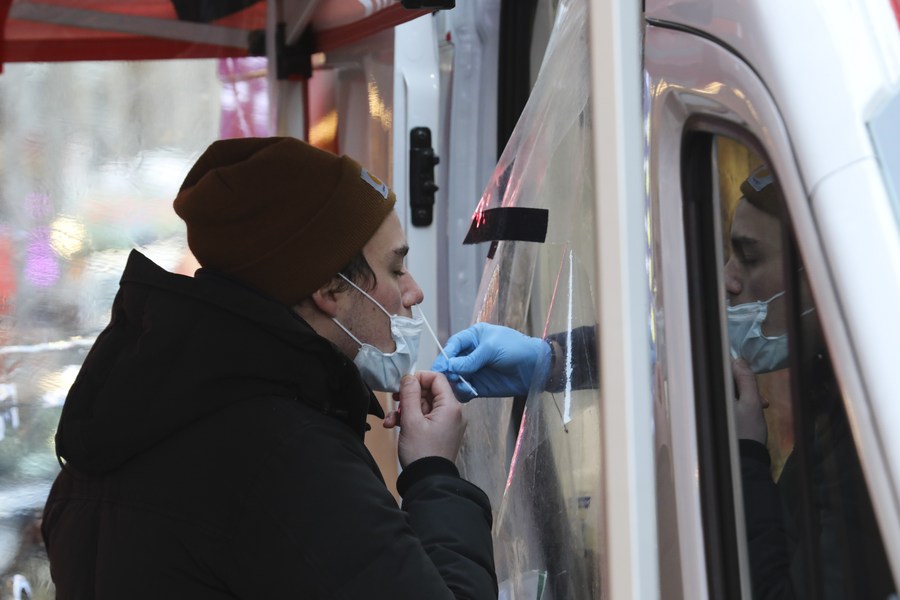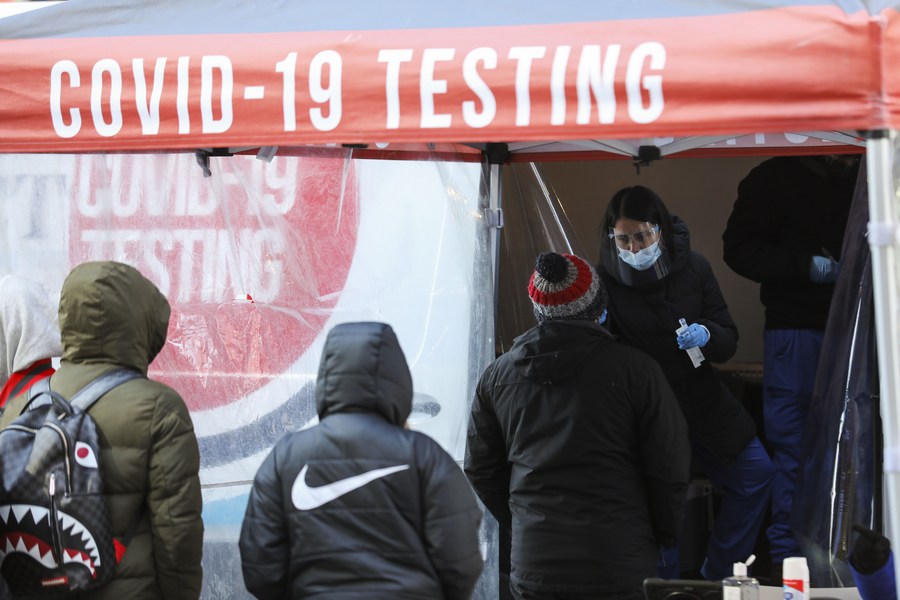Omicron subvariant spreads fast in U.S., causing nearly one quarter of new COVID-19 cases

A man receives a COVID-19 test in New York, the United States, Jan. 4, 2022. (Xinhua/Wang Ying)
-- The BA.2 variant is spreading fast in the United States, with infections nearly doubling every week, according to CDC data.
-- BA.2's prevalence is the highest in the Northeast of the country. In the region spanning New York and New Jersey, the CDC estimated 39 percent of circulating viruses were BA.2.
-- Early studies showed that BA.2 may be up to 30 percent more transmissible than the original Omicron. But so far it does not appear to cause more severe diseases.
WASHINGTON, March 16 (Xinhua) -- The BA.2 sub-lineage of the Omicron variant now makes up nearly a quarter of new COVID-19 infections in the United States, according to the latest data of the U.S. Centers for Disease Control and Prevention (CDC).
This data is up from around 1 in 10 new cases just a week prior.
The BA.2 variant is spreading fast in the country, with infections nearly doubling every week, according to CDC data.
BA.2 accounted for only 1 percent of new cases in the week ending Feb. 5, rising to 2.2 percent in the week ending Feb. 12, and 4.1 percent in the week ending Feb. 19, and 7.1 percent in the week ending Feb. 26, CDC data showed.
The variant was responsible for 23.1 percent of coronavirus infections in the country in the week ending March 12, up from 13.7 percent in the previous week ending March 5, according to the CDC estimates.
BA.2's prevalence is the highest in the Northeast of the country, CDC data showed. In the region spanning New York and New Jersey, the agency estimated 39 percent of circulating viruses were BA.2. In New England, prevalence of BA.2 was at 38.6 percent.
Since January, Omicron has made up virtually all new infections in the United States.
Early studies showed that BA.2 may be up to 30 percent more transmissible than the original Omicron. But so far it does not appear to cause more severe diseases.
Health experts are keeping close watch on the variant, urging the public to remain cautious and not let down guard against COVID-19.

People line up to receive COVID-19 tests on Times Square in New York, the United States, Feb. 14, 2022. (Xinhua/Wang Ying)
"We've been watching it closely," White House press secretary Jen Psaki told reporters on Monday. "We expect some fluctuation, especially at this relatively low level, and, certainly, that to increase."
Despite the spread of the new subvariant, U.S. daily cases and hospitalizations continue to drop while deaths plateau.
Pfizer and BioNTech announced Tuesday that they asked U.S. regulators to authorize a second COVID-19 vaccine booster for people aged 65 and older.
Pfizer cited data from Israel which showed COVID-19 infections were two times lower and rates of severe illness were four times lower among individuals who received a second booster dose of the vaccine, compared to those who received only one booster shot.
If the additional booster was authorized by the U.S. Food and Drug Administration, it would be applied to the group of people who have the highest risk of serious illness and death from COVID-19.
Photos
Related Stories
- China's COVID-hit Jilin builds more makeshift hospitals
- U.S. was gripped by lab conspiracies. Now it's backfired
- Over 3.2 bln COVID-19 vaccine doses administered on Chinese mainland
- Western countries lift COVID-19 bans amid fluctuation of pandemic
- Shanghai renders earnest care to infants amid epidemic resurgence
Copyright © 2022 People's Daily Online. All Rights Reserved.










